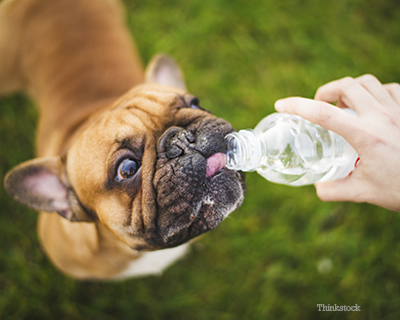
Dr. Justine Lee has some tips to help you pooch avoid heat stroke. For more from Dr. Lee, find her on Facebook!
Earlier this week, we talked about the dangers of heat stroke in dogs, including the 3 most common causes of heatstroke in dogs. Today, we’ll focus on what signs to look for and more importantly, how to prevent it!
Regardless of what the temperature or humidity is, always monitor your dog carefully for signs of fatigue or heat stroke. The sooner you notice these signs, the sooner you should stop any form of exercise, cool down your dog, and seek veterinary attention.  Signs of heat stroke include:
Signs of heat stroke include:
- Constant panting
- Dragging behind (e.g., in other words, on a leash lagging several feet behind you)
- Dry gums that feel sticky to the touch
- Dark red gums
- Vomiting
- Acting wobbly or walking drunk
- Collapse
- An elevated heart rate
- Feeling warm to the touch, with red, flushed skin
- Seizures
- Dark, concentrated urine
The longer heat stroke progresses, the more deadly to your pet. Other life-threatening signs to look for as heat stroke progresses include:
- Seizures or tremors
- Dark red-wine colored urine
- Bloody or black, tarry diarrhea
- Difficulty breathing
- A racing heart rate (due to arrhythmias or abnormal heart rhythms)
- Collapse
- Death
If you notice any of these signs, stop immediately and do the following:
- Call someone who can get their car and bring you to a veterinarian immediately
- Get your dog into the shade or to a water source so you can cool him down (e.g., ask a random person walking by if they have water and dump it on your dog’s head to cool him down).
Unfortunately, even with aggressive supportive care and treatment by your veterinarian, heat stroke can be fatal. The problem is that the heat destroys the cells in the body, resulting in
havoc. Even with aggressive IV fluids, plasma transfusions, antibiotics, cooling measures, anti-vomiting medication, anti-vomiting medication, anti-seizure medication, oxygen therapy, and 24 hour, continuous critical care monitoring, organ failure can still occur.
As treatment for heat stroke is expensive to you and costly to your pet, keep in mind that prevention is key when it comes to avoiding heat stroke.
Some preventative tips on avoiding heat stroke include the following:
- First, always check with your veterinarian to see if your dog is healthy enough – or a breed that is safe - to exercise with you.
- Avoid exercising in the midday sun, which ranges from 10 am – 3 pm. Remember, the head index is very high during this point.
- If possible, make sure to exercise in shade.
- If you’re near a body of water (e.g., water fountain, lake, stream, etc.), take the time to cool your dog down and allow him or her access to a drink while out.
- If you’re not near a water source, make sure to carry a water bottle or Camelback for your dog. If you’re running out for both of you, save that water you’re your four-legged friend instead!
- For you rollerbladers, keep in mind that your dog has to pace at a much faster rate than your walk or jog, so take it easy.
- Prevent your dog from becoming overweight to obese, as this predisposes your pet to overheating.
The easiest hint? When in doubt, STOP. It’s not worth losing your four-legged friend to heat stroke for you to keep in shape!
Dr. Justine Lee
If you have any questions or concerns, you should always visit or call your veterinarian – they are your best resource to ensure the health and well-being of your pets.
Keep Your Dog Cool This Summer: Heat Stroke Part I
